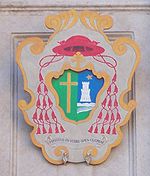Ecclesiastical heraldry is the tradition of heraldry developed by Christian clergy. Initially used to mark documents, ecclesiastical heraldry evolved as a system for identifying people and dioceses. It is most formalized within the Roman Catholic Church, where most bishops, including the Pope, have a personal coat of arms. Similar customs are followed by clergy in the Anglican Church, the Lutheran Church, the Eastern Rite Catholic Churches, and the Eastern Orthodox Churches. Institutions such as schools and dioceses bear arms called impersonal or corporate arms.
Ecclesiastical heraldry differs notably from other heraldry in the use of special symbols around the shield to indicate rank in a church or denomination. The most prominent of these symbols is the ecclesiastical hat, commonly the Roman galero or Geneva Bonnet. The color and ornamentation of this hat carry a precise meaning. Cardinals are famous for the "red hat", but other offices are assigned a distinctive hat color. The hat is ornamented with tassels in a quantity commensurate with the office.
The papal coat of arms has its own heraldic customs, primarily the Papal Tiara (or mitre), the keys of Saint Peter, and the ombrellino (umbrella). Institutional arms have slightly different traditions, using the mitre and crozier more often than personal arms.
